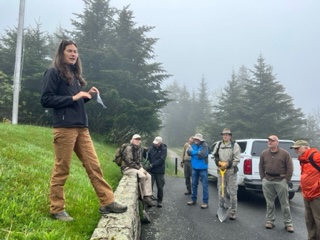An effort to help save one of the Appalachian high country’s most iconic – and at-risk - tree species kicked off May 17 at Mt. Mitchell State Park when two dozen volunteers joined land-use agency staff to plant 300 red spruce seedlings on a wind-swept slope where the trees once towered and thrived.
“It’s good to get these trees in the ground. This is the first spruce-fir restoration project in this area and launches the effort to restore spruce-fir forests in the Black Mountains,” said Sue Cameron, an Asheville-based biologist with the U.S. Fish and Wildlife Service. “Restoration efforts will benefit the ecosystem and the plants and animals that call these forests home.”
High Peaks provided 21 volunteers for the effort, which involved carefully transporting the delicate seedlings up a steep slope, digging holes and planting the young trees on a secluded area of Mt. Mitchell State Park.
Red spruce thrives in colder temperatures and was once a main component of the Eastern forests from the Southern Appalachians north to Canada. The species’ range was halved by logging in the early part of the last century, and the trees now live mainly in isolated patches on high-altitude “islands,” like the Black Mountains.
A very slow-growing species, red spruce struggled to recover from being logged, only to be hit as the last century progressed by new threats like acid rain. The balsam woody adelgid, a non-native insect that kills Frasier fir trees, has also impacted high elevation forests.
The emerging threat of this century is climate change, as higher temperatures stress the trees, increasing their vulnerability to pests and high winds. Improving the health of these forests through restoration efforts will help make them more resilient to a changing climate.
The tree-planting project at Mt. Mitchell is part of a multi-agency effort to give the red spruce a better chance at long-term survival. Formed in 2012, the Southern Appalachian Spruce Restoration Initiative is a partnership of state and federal agencies, NGOs, academic institutions and other groups, including volunteers like the ones from High Peaks.
The initiative will plant trees in other spots around the Southern Appalachians, including the Great Balsams and Virginia Balsams, and then monitor the health and progress of the trees to create baseline data that can be used to guide land managers in the future.
As the "Friends of Mt. Mitchell State Park," High Peaks contributes hundreds of volunteer hours each year maintaining and improving trails at the park.
“High Peaks is glad to contribute to this restoration work on the Black Mountains,” said Russ Oates, a retired Fish and Wildlife Service biologist who organized the Yancey hiking club’s participation. “Our group is dedicated to preserving the area’s exceptional bio-diversity.”
Photo Info: U.S. Fish and Wildlife Service Biologist Sue Cameron gives instructions to volunteers who helped plant 300 red spruce seedlings at Mt. Mitchell recently as part of an effort to save one of the Southern Appalachians’ iconic tree species.

